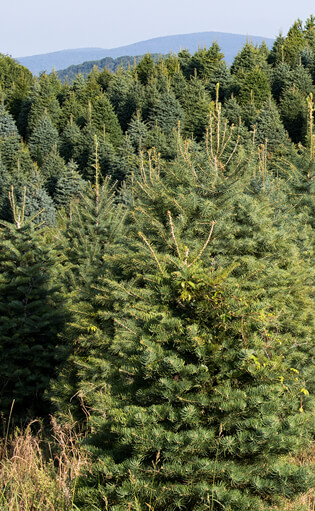White Pine:
The largest pine in the U.S., the white pine has soft, flexible needles and is bluish-green in color. Needles are 2½ - 5 inches long. White pines have good needle retention, but have little aroma. They aren't recommended for heavy ornaments.
White Spruce:
The white spruce is excellent for ornaments; its short, stiff needles are ½ to ¾ in. long and have a blunt tip. They are bluish-green - green in color, but have a bad aroma when needles are crushed. They have excellent foliage color and have a good, natural shape. The needle retention is better in a white spruce than it is among other spruces.
Fraser Fir:
The Fraser fir branches turn slightly upward. They have good form and needle-retention. They are dark blue-green in color. They have a pleasant scent, and excellent shipping characteristics as well.
Colorado Blue Spruce:
Often used for stuffing pine-pillows, these sharp needles are 1 to 1 ½ in. in length. This species is bluish-gray in color. Needles have an unpleasant odor when crushed. This Christmas Tree has good symmetrical form and an attractive blue foliage. It also has good needle retention.
Concolor Fir:
These small, narrow needles are around 1 to 1½ in. in length and occur in rows. They have good foliage color, good needle retention, and a pleasing shape and aroma.
Douglas Fir:
These soft needles are dark green to blue green in color and are approximately 1 to 1 ½ in. in length. Douglas-fir needles radiate in all directions from the branch. When crushed, these needles have a sweet fragrance. They are one of the top major Christmas tree species in the U.S.
Balsam Fir:
These needles are ¾ to 1½ in. in length and last a very long time. This tree has a dark-green appearance and retains its pleasing fragrance throughout the Christmas season.
Scotch Pine:
Approximately 1 in. in length, these needles don't even fall when they're dry, providing excellent needle retention. The color is a bright green. A common Christmas tree in the U.S., the scotch pine has an excellent survival rate, is easy to replant, has great keepability and will remain fresh throughout the holiday season.
Noble Fir:
These needles turn upward, exposing the lower branches. Known for its beauty, the noble fir has a long keepability, and its stiff branches make it a good tree for heavy ornaments, as well as providing excellent greenery for wreaths and garland.
Leyland Cypress:
The most popular Christmas tree in the southeast, the Leyland cypress is dark green-gray in color and has very little aroma. Because it is not in the pine or fir family, it does not produce sap, so those with an allergy to sap can still enjoy a Leyland as their Christmas Tree.
Virginia Pine:
These branches are stout and woody and respond very well to trimming. The tree is small to medium in size and its foliage becomes extremely dense. Aside from being a good nesting site for woodpeckers, the Virginia pine continues to be one of the more popular Christmas tree in the south.
Source: National Christmas Tree Association.


